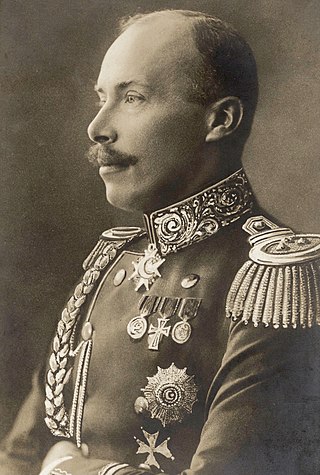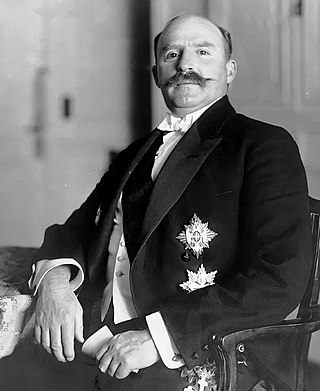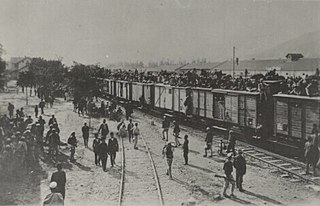Related Research Articles

Wilhelm, Prince of Albania was sovereign of the Principality of Albania from 7 March to 3 September 1914. His reign officially came to an end on 31 January 1925, when the country was declared an Albanian Republic.

Essad Toptani was an Albanian politician who served as prime minister of Albania from 1914 to 1916. He previously established the Republic of Central Albania based in Durrës. An Ottoman army officer, he served as the Albanian deputy in the Ottoman Parliament and later cooperated with the Balkan League after the Balkan Wars.

Isa Boletini was an Albanian revolutionary commander and politician and rilindas from Kosovo.

The Principality of Albania was a short-lived monarchy in Albania, headed by Wilhelm, Prince of Albania, that lasted from the Treaty of London of 1913 which ended the First Balkan War, through the invasions of Albania during World War I and the subsequent disputes over Albanian independence during the Paris Peace Conference of 1919, until 1925, when the monarchy was abolished and the Albanian Republic declared.

Babë Dud Karbunara, born Jorgji Karbunara was an Albanian teacher and politician. He was one of the signatories of the Albanian Declaration of Independence.
Abaz Dilaver Çelkupa or Abaz Efendi Çelkupa was an Albanian politician and one of the delegates and signatories of the Albanian Declaration of Independence in 1912. He was among the key activists of the Albanian National Awakening.

The Republic of Central Albania was a short-lived unrecognised state established on 16 October 1913, with its administrative centre in Durrës, today in Albania.

The Albanian revolt of 1912, was the last revolt against the Ottoman Empire's rule in Albania and lasted from January until August 1912. The revolt ended when the Ottoman government agreed to fulfill the rebels' demands on 4 September 1912. Generally, Muslim Albanians fought against the Ottomans then governed by the Young Turks, an aggressively nationalist revolutionary group, in the incoming Balkan War.

Prenk Bib Doda, also known as Prênk Pasha, was an Albanian member of the Young Turks, prince of Mirdita, and politician in the Principality of Albania.

The Peasant Revolt, also known as the Muslim uprising, was an uprising of peasants from central Albania, mostly Muslims against the regime of Wilhelm, Prince of Albania during 1914. It was one of the reasons for the prince's withdrawal from the country which marked the fall of the Principality of Albania. The uprising was led by Muslim leaders Haxhi Qamili, Arif Hiqmeti, Musa Qazimi and Mustafa Ndroqi. Along with a demand of total amnesty, the rebels required the return of Albania to the suzerainty of the Sultan of the Ottoman Empire.

The International Gendarmerie was the first law enforcement agency of the Principality of Albania. It was established by the decision of the ambassadors of the six Great Powers that participated in the London Peace Conference. This decision was made on the basis of the London Treaty signed on 30 May 1913. Since most of the members were from the Netherlands, this force was also known as the Dutch Military Mission.

The Treaty of Serbian–Albanian Alliance, also known as the Treaty of Niš, was a secret treaty signed in Niš between Essad Pasha Toptani and prime minister Nikola Pašić of Kingdom of Serbia on 17 September 1914.
Mustafa Ndroqi(born Mustafa Mancaku) was an Albanian landowner who played an important role in the Revolts of 1914–15.

The Royal Palace of Durrës, sometimes known as the Konak of Durrës, was a royal palace of the Principality of Albania situated in Durrës, Albania. It previously served as the chief official residence of Wilhelm, Prince of Albania, and his wife, Princess Sophie of Schönburg-Waldenburg. It has been used by different Albanian governments for various purposes.

Aziz Pasha Vrioni (1859–1920) was an Ottoman-Albanian politician of the early 20th century. He was a member of the Ottoman Parliament representing Berat, and Albanian Minister of Finance and Minister of Agriculture and of Mines.

Haxhi Qamili, born Qamil Zyber Xhameta, was the leader of the 1914–15 revolt in Albania. He was popularly known by his religious name Haxhi Qamili, though he was also known as Baba Qamili.

Sulejman Zalla (1892–1966) was an Albanian teacher, patriot and activist of the Rilindja Kombëtare of the early 20th century. He was the founder of the first modern Albanian school in the County of Durrës.

Aqif Pasha Biçaku mostly known as Aqif Pashë Elbasani was an Ottoman Albanian political figure in the Sanjak of Elbasan and after the Young Turk Revolution became an activist for the Albanian national cause.
Haxhi Isuf Banka (Zhelegu) (1864 – September 1, 1944) was an Albanian economist and politician who served as Minister of Finances in the Toptani Government.
The Taksim meeting alternatively known as the Taksim Plot and less commonly as the Taksim Assembly was a secret meeting held in January 1912 by Albanian nationalist deputies of the Ottoman parliament and other prominent Albanian political figures. The event gets its name from Taksim Square because of the location of the house where it was held. The meeting was organized on the initiative of Hasan Prishtina and Ismail Qemali, Albanian politicians, who invited most of the MPs of Albanian origin and aimed at launching an armed general uprising in Albanian territories against the central government headed by the Committee of Union and Progress (CUP). The meeting followed two other Albanian uprisings of 1910 in the Vilayet of Kosovo and 1911 in the mountains of upper Shkodra. The Taksim meeting resulted in an uprising the same year, with armed uprisings in Shkodër, Lezhë, Mirditë, Krujë and other Albanian provinces, which exceeded the organizers' expectations. The biggest uprising was in Kosovo, where the rebels were more organized and managed to take over important cities like Prizren, Peja, Gjakova, Mitrovica and others.
References
- 1 2 3 4 Kristo Frashëri (2008). Historia e qytetërimit shqiptar: nga kohet e lashta deri ne fund të Luftës së Dytë Botërore. Akademia e Shkencave e Shqipërisë. p. 245.
- 1 2 Jonilda Rrapaj and Klevis Kolasi (2013). "The Curious Case of Albanian Nationalism: the Crooked Line from a Scattered Array of Clans to a Nation-State" (PDF). The Turkish Yearbook of International Relations. 43. Ankara University, Faculty of Political Science: 185–228. doi:10.1501/intrel_0000000290. S2CID 29750907. Archived from the original (PDF) on 2018-06-27.
- 1 2 3 4 5 6 7 8 9 10 11 12 13 14 15 16 17 18 19 Abas Ermenji (January 14, 2018). "LEVIZJA DUMBABISTE (TURKOMANE) E MUSA QAZIMI, LEVIZJE ANTISHQIPTARE (1914)". Vendi që zë Skënderbeu në historinë e Shqipërisë. Çabej. p. 369. Archived from the original on August 12, 2018. Retrieved August 11, 2018.
- 1 2 3 4 5 6 7 8 9 10 11 12 13 14 15 16 Gazmend Bakiu and Kastriot Dervishi. "Musa QAZIMI -- N/Prefekt i Tiranes 1913-1914". Tirona. Archived from the original on 2018-08-10. Retrieved 2018-08-10.
- ↑ Vickers, Miranda (2006) [1995]. The Albanians: a modern history. London: I.B. Taurus. p. 82. ISBN 1-86064-541-0 . Retrieved January 8, 2011.
The Young Turks ... still had hopes for restoring Ottoman suzerainty over Albania. They therefore sent agents to encourage insurrection...
- ↑ Bataković, Dušan (1992). "Albanian Incursions into Serbia". In Ivan Čolović (ed.). The Kosovo Chronicles. Belgrade: Knjižara Plato. ISBN 86-447-0006-5 . Retrieved January 8, 2011.
around 20,000 ethnic Albanians who fled Old Serbia and Macedonia found themselves on Albanian soil, while their leaders Hasan Pristina and Isa Boljetinac sat in the government at Valona. Austro-Hungarian and Italian emissaries and agents, mostly the clergy and teachers, suppressed Essad Pasha's influence and appealed to the ethnic Albanians to rise against the Serbs
- ↑ Vickers, Miranda (2006) [1995]. The Albanians: a modern history. London: I.B. Taurus. p. 82. ISBN 1-86064-541-0 . Retrieved January 8, 2011.
Serbia had come to an understanding with Essad. ...Essad Pasha will be sent money, military plan calls for the complete annihilation ..... of Ismail Kemal, Isa Boletini and their friends,.... to undertake boundary rectification, in accordance with Serbia's wishes, up to the Black Drin.
- 1 2 3 "A duhet ndryshuar historia e Kombit tonë?". noa.al (in Albanian). Retrieved 2017-10-29.
- ↑ Gazmend Shpuza (1986). Kryengritja fshatare e Shqipërisë së Mesme 1914-1915. Akademia e Shkencave e RPS të Shqipërisë, Instituti i Historisë. p. 339.
- ↑ Kraja, Abedin (2012). "Babë Dudë Karbunara, si u masakrua para popullit firmëtari i Pavarësisë". Gazeta Shqiptare Online(Balkanweb) (in Albanian). Archived from the original on 4 February 2014. Retrieved 13 October 2012.
- 1 2 3 "Babe Dude Karbunara, mesues dhe atdhetar i shquar". Telegraf.Al. May 5, 2015.
- ↑ "Forsaken Albania". Tirana Times. August 6, 2006.